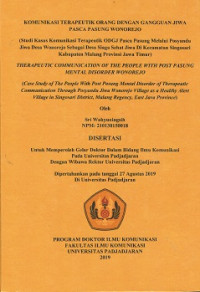
Disertasi/Tesis/Skripsi
Komunikasi Terapeutik Orang Dengan Gangguan Jiwa Wonorejo : Studi Kasus Komunikasi Terapeutik ODGJ Pasca Pasung Melalui Posyandu Jiwa Desa Wonorejo Sebagai Desa Siaga Sehat Jiwa di Kecamatan Singosari Kabupaten Malang Provinsi Jawa Timur
ABSTRAK Orang Dengan Gangguan Jiwa (ODGJ) pasca pasung, menurut survei terpadu yang dilakukan oleh seluruh petugas kesehatan Puskesmas ...
-
Code CallNo Lokasi Ketersediaan K3K0199 616.891 4 SRI k Perpustakaan FIKOM UNPAD (Rak Layanan Karya Ilmiah) Tersedia -
Perpustakaan Fakultas Ilmu KomunikasiJudul Seri -No. Panggil 616.891 4 SRI kPenerbit Fikom Unpad : Bandung., 2019 Deskripsi Fisik xix , 405 hlm. : Ilus. ; 21 cm.Bahasa IndonesiaISBN/ISSN -Klasifikasi 616.891 4 SRI kTipe Isi textTipe Media -Tipe Pembawa -Edisi -Subyek Info Detil Spesifik -Pernyataan Tanggungjawab - -
ABSTRAK Orang Dengan Gangguan Jiwa (ODGJ) pasca pasung, menurut survei terpadu yang dilakukan oleh seluruh petugas kesehatan Puskesmas Ardimulyo Kecamatan Singosari kabupaten Malang, bekerja sama dengan kader-kader posyandu, bahwa jumlahterbanyak adalah desa Wonorejo Kecamatan Singosari Kabupaten Malang Provinsi Jawa Timur yaitu berjumlah 37 orang, tetapi peneliti fokus pada ODGJ pasca pasung yang berjumlah 7 orang. Setelah mereka mendapatkan perawatan dari Rumah Sakit Jiwa Lawang, kemudian mereka mendapatkan perawatan Posyandu Jiwa di desa Wonorejo melalui komunikasi terapeutik. Dari kasus-kasus kejiwaan di desa Wonorejo, banyak aktivitas psikoterapi dan sosial terapi di lingkungan keluarga ODGJ pasca pasung di desa Wonorejo. Tujuan penelitian ini adalah menggali dan mengungkapkan metode komunikasi terapeutik tenaga kesehatan untuk ODGJ pasca pasung di Posyandu Jiwa desa Wonorejo; 2) menggali dan mengungkapkan aktivitas komunikasi terapeutik keluarga, kader jiwa, dan perawat ketika di lingkungan rumah pasien ODGJ pasca pasung; 3) Menggali dan mengungkapkan hambatan-hambatan komunikasi terapeutik tenaga kesehatan, kader jiwa, dan keluarga terhadap pasien ODGJ pasca pasung; 4) Menggali dan mengungkapkan kontinuitas pelaksanaan komunikasi terapeutik untuk pasien ODGJ pasca pasung. Metode penelitiannya adalah kualitatif, dengan paradigma konstruktivistik. Pendekatan penelitian ini adalah studi kasus. Penelitian ini menggunakan purposive sampling. Dari kriteria yang didapatkan, subjek penelitiannya adalah 2 psikiater, 2 pegawai PKRS (Promosi Kesehatan Rumah Sakit), 3 perawat, 7 keluarga pasien. Objek penelitiannya adalah komunikasi terapeutik tenaga kesehatan, kader jiwa, keluarga, dan pasien di Posyandu Jiwa desa Wonorejo. Metode pengumpulan datanya adalah observasi, wawancara mendalam, dukumentasi, dan bahan audio visual. Validitas datanya adalah triangulasi, perpanjangan keikutsertaan, ketekunan pengamatan, pengecekan melalui diskusi, kecukupan referensi, dan member check. Hasil penelitiannya adalah 1) Metode komunikasi terapeutik yang dilakukan psikiater bersama perawat kepada pasien gangguan jiwa, pertama, telepsychiatrytherapydan psychopharmaca therapy; kedua, metode rehabilitasi mental dilakukan perawat bersama kader jiwa diantaranya sport therapy, handycraft therapy, psychoreligious therapy, dan activity group therapy;2) Aktivitas komunikasi terapeutik pertama, aktivitas komunikasi keluarga untuk pasien gangguan jiwa adalah terapi komunikasi keluarga, dan terapi komunikasi obat; kedua,Aktivitas komunikasi perawat dan kader jiwa, adalah home visite, dan psikoedukasi keluarga pasien; 3) Hambatan-hambatan komunikasi terapeutiknya adalah jaringan lemah, noisesuara, bahasa, kurang kooperatif, pendidikan, koherensi, stranger anciety, emosional dan penampilan perawat; 4) Kontinuitas komunikasi psikoedukasi dilakukan untuk pasien karena daya tahan stress pasien relatif rendah, agar pasien tetap stabil, bisa menggali kebutuhan-kebutuhan pasien, meminimalisir pasien kambuh dan melamun, meminimalisir stigma dari masyarakat, tidak re-pasung, dan tidak re-dukun.Kata Kunci: Komunikasi Terapeutik, ODGJ Pasca Pasung, Telepsychiatry Therapy, Psychopharma Therapy, Rehabilitasi Mental
viABSTRACTPeople with mental disorders (ODGJ) in pasungterm, according to an integrated survey can be doneby all health workersof Ardimulyo Singosari of Malang, in collaboration with posyandu Caders that the total number was 37 people at Wonorejo village of Singosari-Malang of East Java Province, but the researchers focused on post pasungwhich numbered 7 people. After taking carefrom the Mental Hospitalof Lawang, then theytake carefor the PosyandujiwaatWonorejo village through therapeutic communication. From psychiatric cases atWonorejo village, there are many psychotherapy and socialtherapy activities in post pasungoffamily environment. The purpose of this study is 1) to explore and reveal the therapeutic communication methods of health workers in the Posyandu Jiwa of Wonorejo village; 2) to explore and reveal the therapeutic communication activities of families, mental cadres, and nurses in patient's home environment; 3) to Dig and reveal cases in the therapeutic communication of health workers,mental cadres, and families toward the patientsof post pasung; 4)to Explore and reveal the continuity of implementation oftherapeutic communication for patient’s post pasung.The research method is qualitative, with a constructivist paradigm. This research approach is a case study. This research uses purposive sampling. From the criteria obtained, the research subjects were 2 psychiatrists, 2 employer of PKRS(Hospital Health Promotion), 3 nurses, 7 patient’sfamilies. The object of his research was the therapeutic communication of health workers, mental cadres, families, and patients atthe Posyandu Jiwa of Wonorejo village. Data collection methods are observation, in-depth interviews, documentation, and audio-visual material. The validity of the data is triangulation, extension of participation, perseverance of observation, checking through discussion, adequacyof references, andcheckmembers.The results of his research are 1) Therapeutic communication methods performed by psychiatrists with nurses to mental patients, first, telepsychiatry therapy and psychopharmaca therapy; second, mental rehabilitation methods are performed by nurses and mental cadres including sports therapy, handicraft therapy, psych religious therapy, and activity group therapy; 2) The first therapeutic communication activity, family communication activity for psychiatric patients is family communication therapy, and drug communication therapy; second, communication activities of nurses and mental cadres, is home visit, and patient’s family of psycho education; 3) the problem of therapeutic communication are weak networks, noise, language, lack of cooperation, education, coherence, stranger anxiety, emotional and nurse's appearance; 4) Continuity communication of psych education is done for patients because the patient's stress resistance is relatively low, so that patients remain stable, can explore patient needs, minimize patient relapse and daydreaming, minimize stigma from the community, not pre-pasung, and not pre-supranatural.Keywords: Therapeutic Communication, ODGJ Post Pasung, Telepsychiatry Therapy, Psychopharma Therapy, Mental Rehabilitation -
Tidak tersedia versi lain
-
Silakan login dahulu untuk melihat atau memberi komentar.






